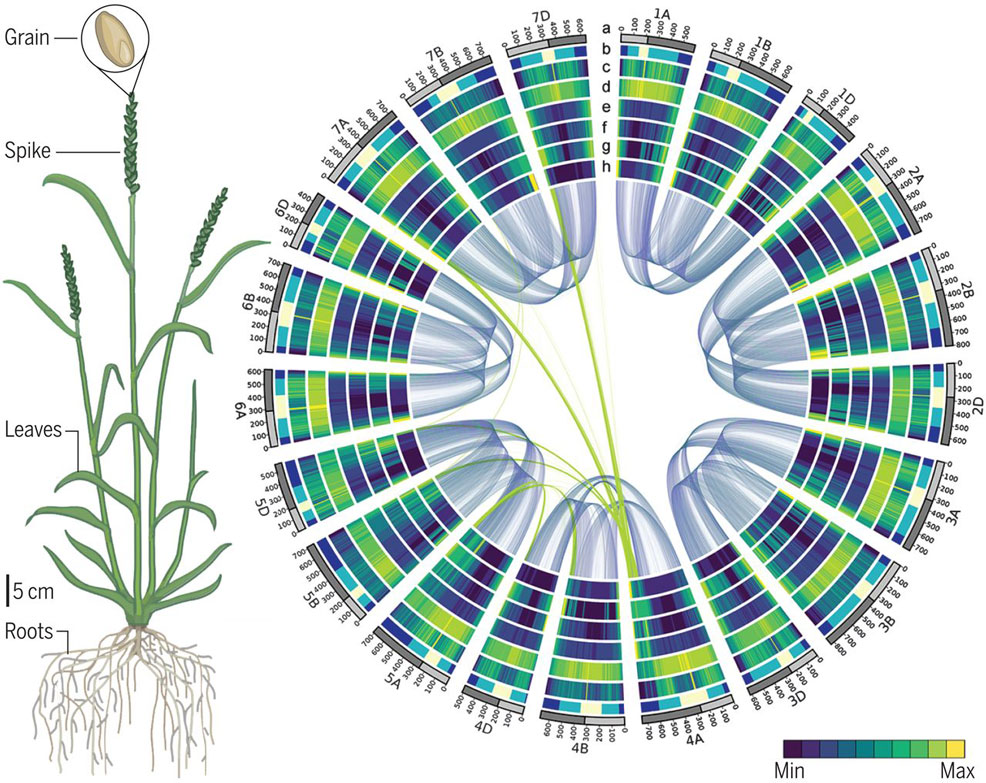
19th August 2018 The wheat genome is fully sequenced After a 13 year effort, an international team of scientists has produced the first complete map of the wheat genome. This achievement could lead to better crop varieties that are more adapted to environmental conditions, as well as providing new ways of treating certain wheat-immune diseases and allergies.
The International Wheat Genome Sequencing Consortium (IWGSC) this week published a detailed description of the bread wheat genome, the world's most widely cultivated crop. Their work paves the way for the production of new wheat varieties that are better adapted to climate change, with higher yields, enhanced nutritional quality and improved sustainability. Authored by more than 200 scientists from 73 research institutions, the paper appears in the journal Science and presents the reference genome of the bread wheat variety Chinese Spring. The DNA sequence ordered along the 21 chromosomes is the highest quality sequence produced to date for wheat and is the result of 13 years of international collaboration. A key crop for food security, wheat is the staple food of more than a third of the global human population and accounts for almost 20% of the total calories and protein consumed by humans worldwide – more than any other single food source. It also serves as an important source of vitamins and minerals. To meet future demands of a projected world population of 9.7 billion by 2050, wheat productivity needs to increase by 1.6% each year. In order to preserve biodiversity, water, and nutrient resources, the majority of this increase has to be achieved via crop and trait improvement on land currently cultivated rather than committing new land to cultivation. With the reference genome sequence now completed, breeders have at their disposal new tools to address these challenges. They will be able to identify more rapidly the genes and regulatory elements underlying many complex agronomic traits such as yield, grain quality, resistance to fungal diseases and tolerance to abiotic stress.
The availability of a high-quality genome map is expected to boost wheat improvement over the next few decades, with benefits similar to those observed for rice and maize after their sequences were produced in 2002 and 2009, respectively. "We need to find ways to make sustainable production of wheat in the face of climate change and increasing demand," said Prof. Cristobal Uauy a project leader in crop genetics at the John Innes Centre, Norwich. "This is something we've been waiting for for many years. The whole of human civilisation should be very excited with this, because for the first time now we'll be able to make the advances that scientists and plant breeders have wanted to do in wheat in a much more targeted manner and so feed the world in the future." "How do you thank a team of scientists who persevered and succeeded in sequencing the wheat genome and changed wheat breeding forever?" said Professor Stephen Baenziger from the University of Nebraska-Lincoln, and the Nebraska Wheat Growers Presidential Chair. "Perhaps it is not with the words of a scientist, but with the smiles of well-nourished children and their families whose lives have been changed for the better." Sequencing the wheat genome was long considered an impossible task, due to its enormous size – five times larger than the human genome – as well as its tremendous complexity: bread wheat has three sub-genomes and more than 85% of the genome is composed of repeated elements. "The publication of the wheat reference genome is the culmination of the work of many individuals who came together under the banner of the IWGSC to do what was considered impossible," explained Kellye Eversole, Executive Director of the IWGSC. "The method of producing the reference sequence and the principles and policies of the consortium provide a model for sequencing large, complex plant genomes and reaffirms the importance of international collaborations for advancing food security." In addition to climate change and other environmental threats, a number of wheat-immune diseases and allergies could potentially be dealt with – such as celiac, baker's asthma and wheat-dependent exercise-induced anaphylaxis. Exposure to specific proteins in wheat can cause severe allergic reactions in some people. However, due to the complexity of the wheat genome and the lack of complete genome information for this crop, a detailed understanding of the nature of these proteins has remained elusive until now. In addition to the 21 chromosomes, the precise location of 107,891 genes and more than four million molecular markers has been revealed, as well as sequence information between the genes and markers containing the regulatory elements influencing the expression of genes. This result was achieved by combining the resources generated over the last 13 years using classic physical mapping methods and the most recent DNA sequencing technologies; the sequence data were assembled and ordered along the 21 chromosomes using highly efficient algorithms, and genes were identified with dedicated software programs.
Comments »
If you enjoyed this article, please consider sharing it:
|








